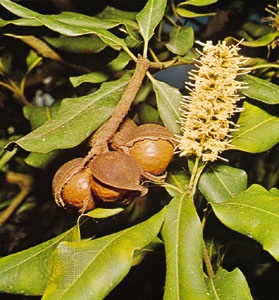macadamia
plant
 (Macadamia), any of about 10 species of ornamental evergreen tree belonging to the family Proteaceae, producing an edible, richly flavoured dessert nut.
(Macadamia), any of about 10 species of ornamental evergreen tree belonging to the family Proteaceae, producing an edible, richly flavoured dessert nut.Macadamias originated in the coastal rain forests and scrubs of what is now Queensland in northeastern Australia. The macadamias grown commercially in Hawaii and Australia are principally of two species, the smooth-shelled Macadamia integrifolia and the rough-shelled M. tetraphylla; the two tend to hybridize beyond distinction, and trees grown as M. ternifolia are usually one of these two species. Because of the successes of the Hawaiian nut industry, other subtropical regions have planted macadamia orchards. Large acreages are planted in South Africa, Zimbabwe, and Malawi and parts of South and Central America.
As an orchard crop, the macadamia needs rich, well-drained soil and 130 centimetres (50 inches) of rain annually. Macadamia trees commonly grow to 18.3 metres (60 feet) high and 15.2 m wide. The everbearing trees have shiny, leathery leaves that are 20–30 cm long. Fragrant pink or white flower clusters are succeeded by bunches of one to 20 fruits. The shiny, round, 25-millimetre (1-in.) nuts have a thick, leathery husk called a pericarp that splits along one side during the ripening process. Because it is difficult to tell precisely when the nut is ripe, the macadamias are not harvested until they drop to the ground. The mature nuts are then gathered by hand and machine-hulled, dried, and stored for processing. In Hawaiian factories, the nuts are roasted, usually in oil, salted, and packed. Some of the crop is used by bakers in confections. The nuts are a good source of calcium, phosphorus, iron, and vitamin B; they contain 73 percent fat. Because macadamias are difficult to propagate, slow to bear, and limited in range of cultivability, production has not kept pace with increased demand, thus rendering the product costly.
- Jacobus Johannes Pieter Oud
- Jacobus Nienhuys
- Jacobus Revius
- Jacobus van Looy
- Jacob van Artevelde
- Jacob van Campen
- Jacob van Heemskerck
- Jacob van Lennep
- Jacob van Maerlant
- Jacob van Ruisdael
- Jacob Viner
- Jacob Wackernagel
- Jacoby, Oswald
- Jacob Zuma
- Jacobābād
- Jacopo Bassano
- Jacopo Bellini
- Jacopo da Pontormo
- Jacopo de' Barbari
- Jacopo Della Quercia
- Jacopo Nardi
- Jacopone Da Todi
- Jacopo Palma
- Jacopo Peri
- Jacopo Sannazzaro